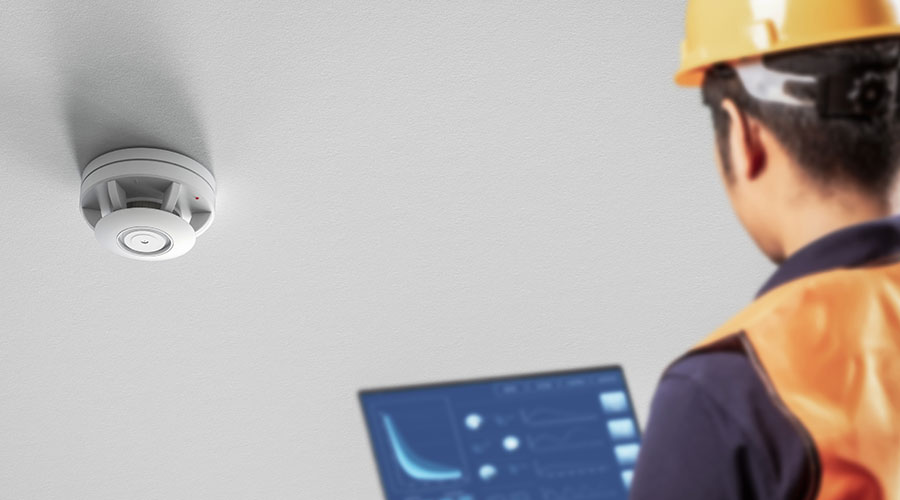Inside Wet and Dry Sprinkler Systems
The benefits of installing sprinkler systems in a facility are irrefutable. Consider this: No multiple loss of life has occurred in a fully-sprinklered building due to fire or smoke, aside from the deaths of firefighters or fatalities due to explosions, the National Fire Sprinkler Association (NFSA) reports.
An NFSA study of fires and fatalities occurring between 1971 and 1975 found that about 20 lives were lost annually in sprinklered buildings, compared with 4,000 deaths in buildings without sprinklers.
Of course, for sprinklers to do their job — to operate automatically to keep fires from growing undetected — they require regular maintenance, testing and inspection. A lack of proper maintenance can lead to sprinklers that are obstructed by dirt, dust, or even paint, says Jim Lake, senior fire protection specialist with the National Fire Protection Association (NFPA). Or the water pressure may be insufficient. When any of these things happen, the sprinklers won't operate effectively.
Two NFPA standards generally govern sprinkler installation and maintenance. As its title indicates, NFPA 13, "Standard for the Installation of Sprinkler Systems," regulates sprinkler installation. "Usually, the building codes say that if you have a sprinkler, it must comply with NFPA Standard 13," says Chris Jelenewicz, engineering program manager with the Society of Fire Protection Engineers.
Another standard, NFPA 25, "Standard for the Inspection, Testing and Maintenance of Water-Based Fire Protection Systems," covers sprinklers once they're up and running. NFPA 25 tells people what needs to be done to test and maintain sprinklers, says Ken Isman, vice president of engineering with the National Fire Sprinkler Association. Beyond these regulations, some building codes contain additional requirements.
Sprinkler Types and Components
The appropriate maintenance and inspections schedule will vary depending on the type of sprinkler installed. Most sprinklers fall into one of four categories.
Wet sprinklers are the most common and simplest. "It's basically a network of piping filled with water. At the end of the piping is the sprinkler," says Jelenewicz. When a fire occurs, the heat activates the system, allowing the water to flow. Because wet sprinklers are the simplest type, they require the least amount of inspection, maintenance and testing.
Another category includes dry sprinklers. Although the term "dry sprinkler" sounds like an oxymoron, these are designed for systems in which the pipes may be exposed to temperatures below 40 F, and thus are liable to freeze, Jelenewicz says. Here's how they work: Pressurized air holds back the water at the main sprinkler valve. When a sprinkler is activated, the air discharges from the system, causing the air pressure to drop, and water to flow to the open sprinklers.
Because of the time lag — generally, no more than 60 seconds — before the water in a dry system begins to flow, these sprinkler systems are less desirable than wet ones. "We try to discourage these, because there's a delay in getting water to the fire," Isman says. In addition, dry systems are more complicated, which increases the work required to maintain them.
A third sprinkler type is pre-action. These typically are used in areas such as computer labs, where the property being protected can be easily damaged by water. Pre-action systems are similar to dry systems, except that a lower level of air pressure is maintained within the network of pipes, Jelenewicz says. The air is used to monitor the piping and sense pressure changes; it doesn't actually hold back the valve, as it does in a dry system. Instead, the valve is closed, and needs to be opened by a signal from a detection system, such as a heat or smoke detector. Once the system is activated, the valve opens and water flows into the pipes.
The benefit of a pre-action system? Water will flow only from the activated sprinkler. If the system piping or a sprinkler is accidentally damaged, water won't automatically flow.
As with dry systems, pre-action systems require a greater level of maintenance and testing. That's because both the detectors and activation mechanisms need to be regularly checked. And reliability can be reduced because you have to rely on another system to activate the sprinklers.
Finally, deluge systems are used in locations in which vast quantities of water would be needed to control a fire. An example would be in facilities that store highly volatile materials with the potential to burn extremely rapidly or explode. While many media portrayals of sprinklers seem to show deluge systems, these are only rarely used in real life, Isman says.
No matter which type of system is installed, several components are common to most. The first and most important is a water supply. "If the water supply itself isn't adequate, the rest of the system, no matter how well-designed, won't work the way it should," says Jelenewicz. As a starting point, each sprinkler system needs at least one source of water that is automatic — that is, it doesn't require human intervention to activate it.
The degree of water pressure required is dictated by the building and its use. A high-rise office tower will need greater pressure than a three-story building. Similarly, a lumberyard storing piles of wood probably will need greater capacity than an office building. If the municipal water supply is insufficient to properly sprinkler the building, it may need to be supplemented with a fire pump. The fire pump is activated when water pressure in the sprinkler system falls below a minimum threshold.
In addition, each system needs some network of pipes, valves and sprinklers through which the water can flow, notes Lake. Most facilities in earthquake-prone areas also use extra bracing to protect the sprinkler system from tremors.
Related Topics:












